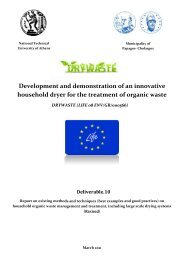MOROCOMP (LIFE TCY05/MA000141) - Unit of Environmental ...
MOROCOMP (LIFE TCY05/MA000141) - Unit of Environmental ...
MOROCOMP (LIFE TCY05/MA000141) - Unit of Environmental ...
You also want an ePaper? Increase the reach of your titles
YUMPU automatically turns print PDFs into web optimized ePapers that Google loves.
9<br />
pH<br />
8<br />
7<br />
6<br />
1 3 5 7 9 11 13 15 17 19 21 23 25 27 29<br />
Days<br />
Figure 5: Changes in pH values during the 1 st composting trial<br />
The pH <strong>of</strong> the extracts increased during the first 8 days <strong>of</strong> the 1 st composting trial.<br />
This is more probably related to the degradation <strong>of</strong> the organic matter, which releases<br />
ammonia [17]. At the onset <strong>of</strong> composting, compounds such as amino acids, proteins<br />
etc. were mineralized through the activity <strong>of</strong> proteolytic bacteria to give ammonia and<br />
thus the pH value increased reaching a maximum <strong>of</strong> 8.86 on the 8 th day. Thereafter,<br />
through ammonia volatilization and its oxidation to nitrates by the action <strong>of</strong><br />
nitrobacteria, the ammonia content decreased and thus the pH value drops from 8.86<br />
to 7.31 on the 30 th and final day <strong>of</strong> the process [12, 18].<br />
5.1.6.2. Total Carbon<br />
During composting, controlled microbial transformation <strong>of</strong> the organic matter that is<br />
present in the compostable material takes place. Part <strong>of</strong> the organic matter is<br />
mineralized to carbon dioxide, ammonia and water. The carbon loss occurs through<br />
bio-oxidation <strong>of</strong> organic carbon to CO 2 during composting. The CO 2 can escape as a<br />
gas or dissolve in the liquid, forming carbonic acid (H 2 CO 3 ) bicarbonate (HCO - 3 ) and<br />
carbonate (CO 2- 3 ). The other part <strong>of</strong> the organic carbon is transformed into humic<br />
substances which are structurally very similar to those present in soils. Figure 6<br />
presents the total carbon evolution during the 1 st composting trial.<br />
40










